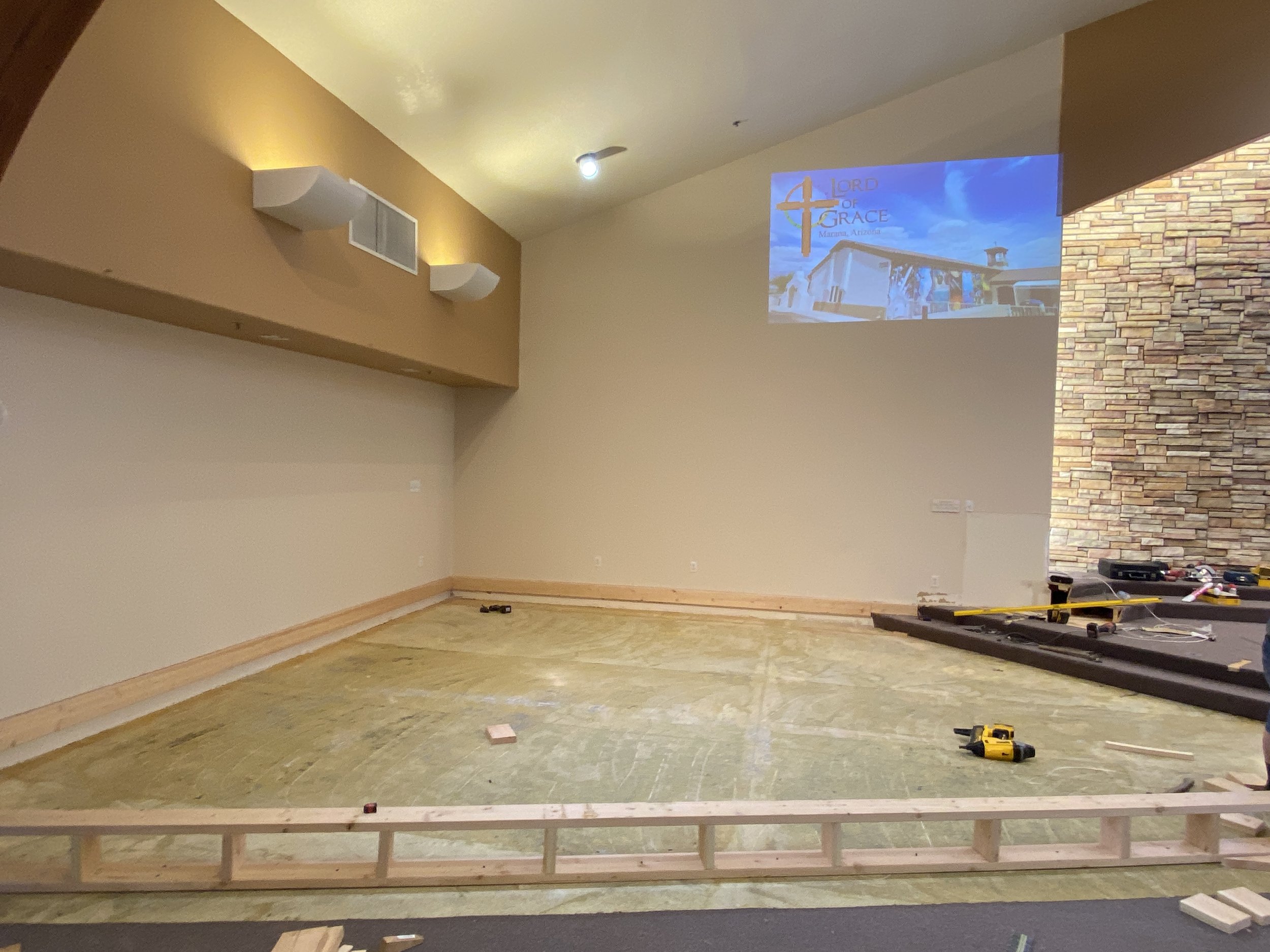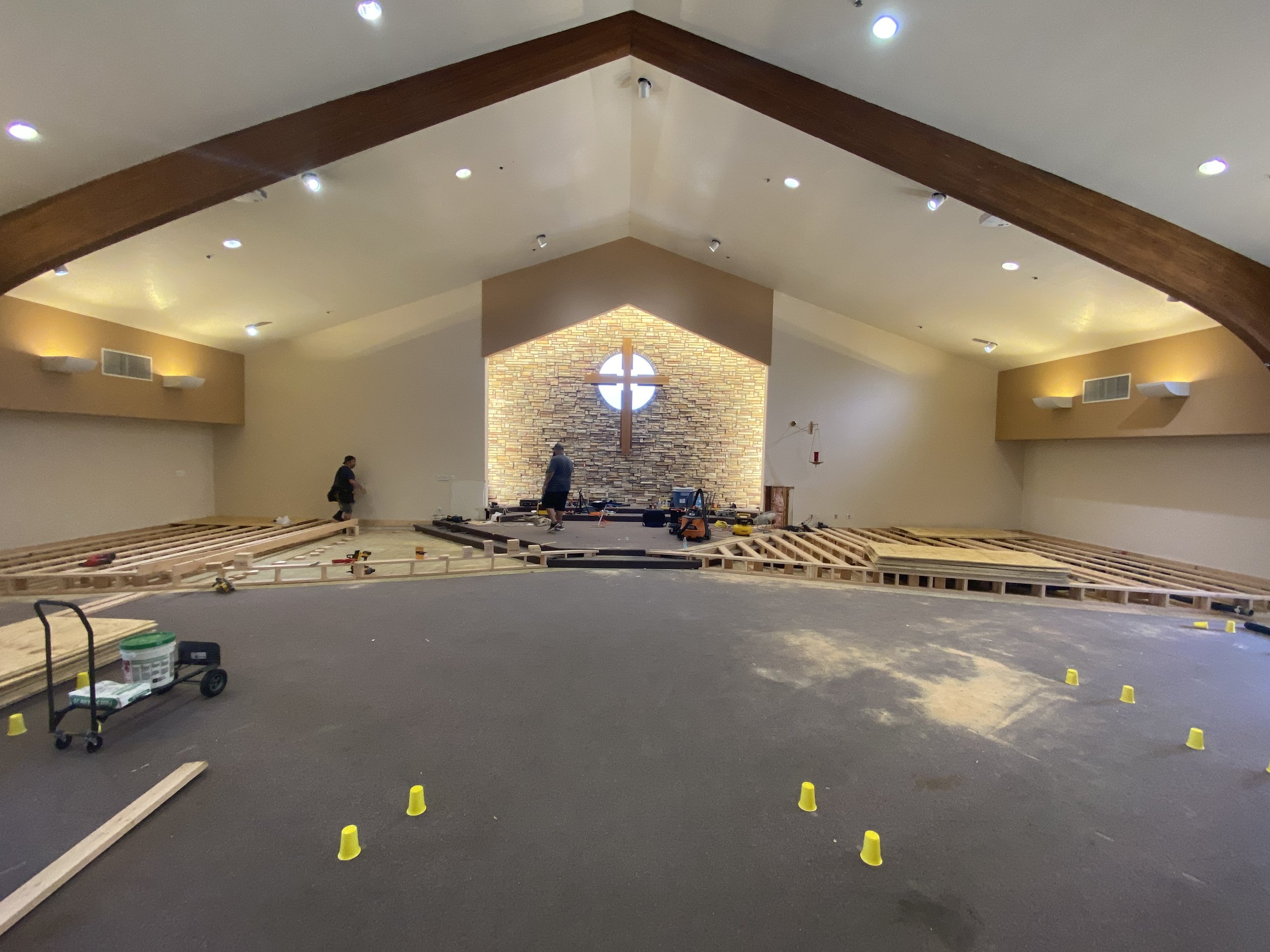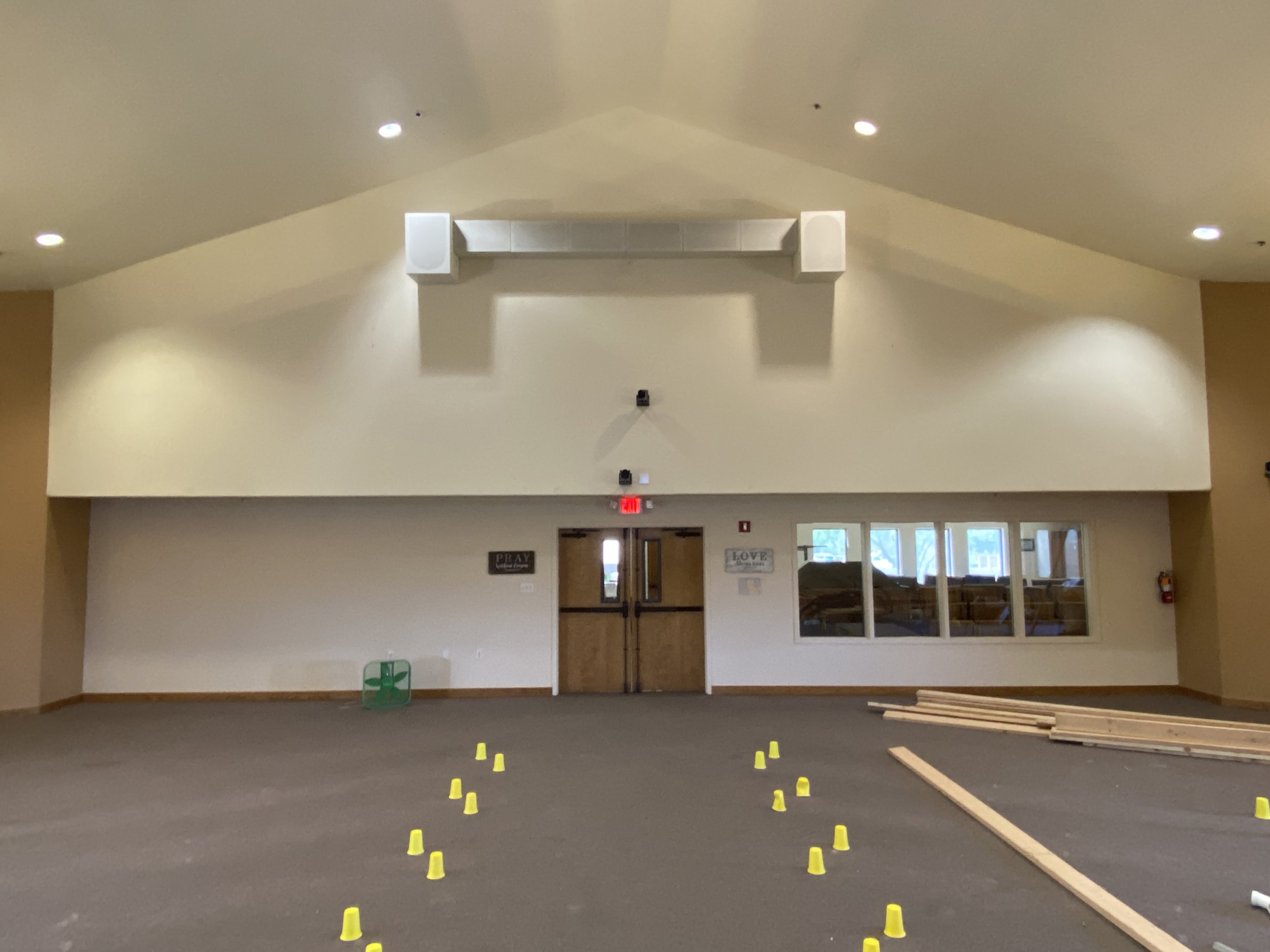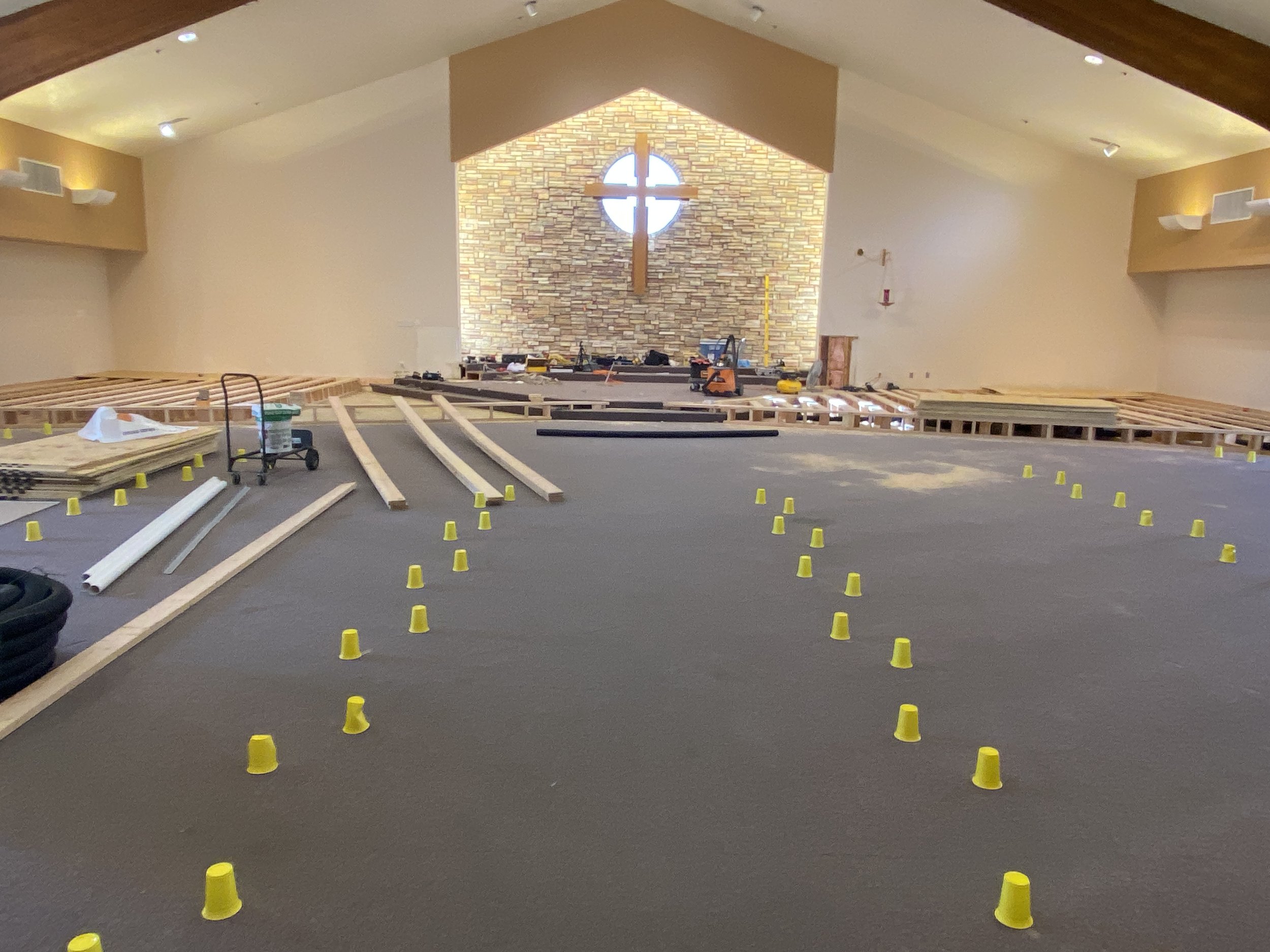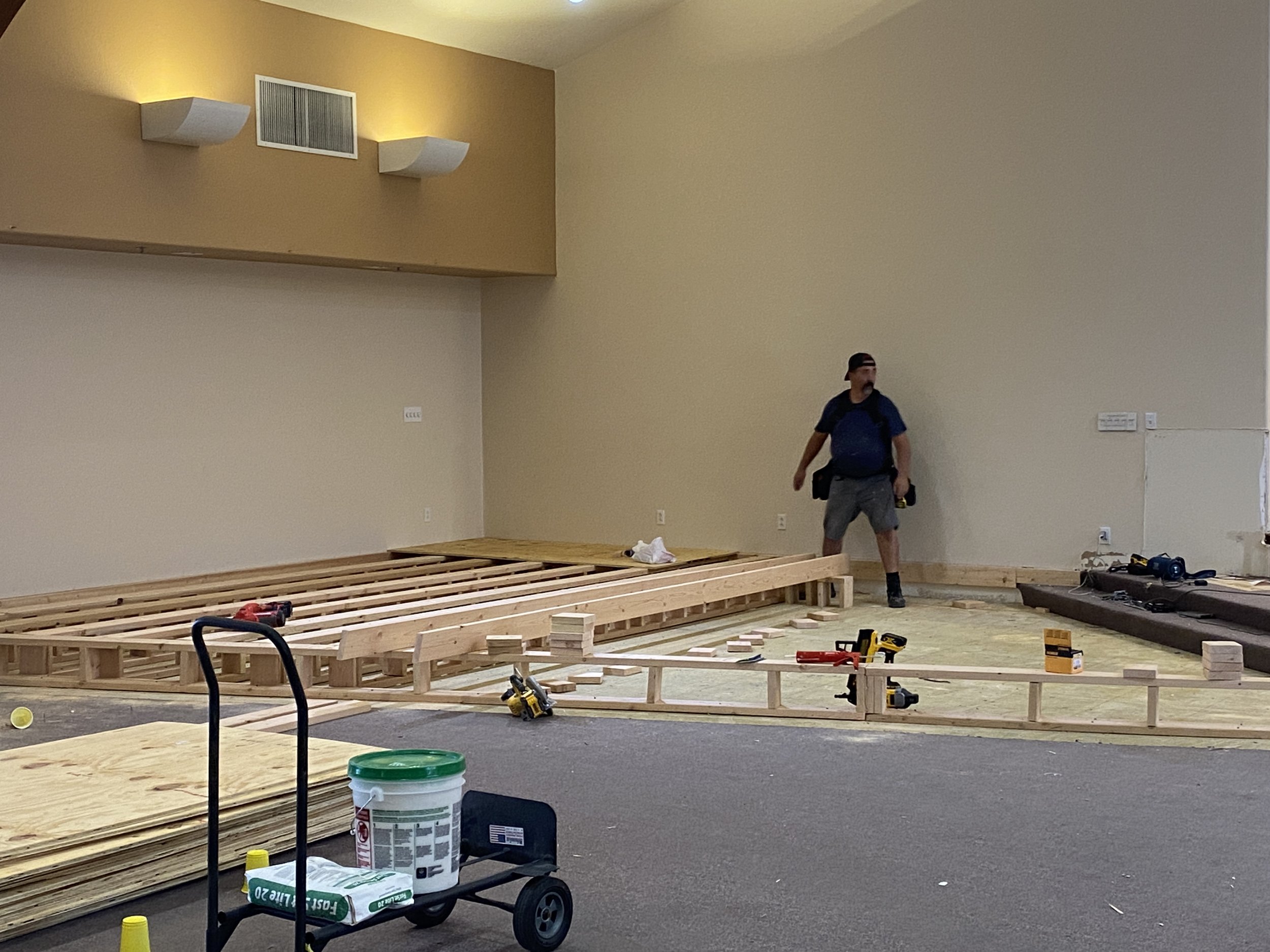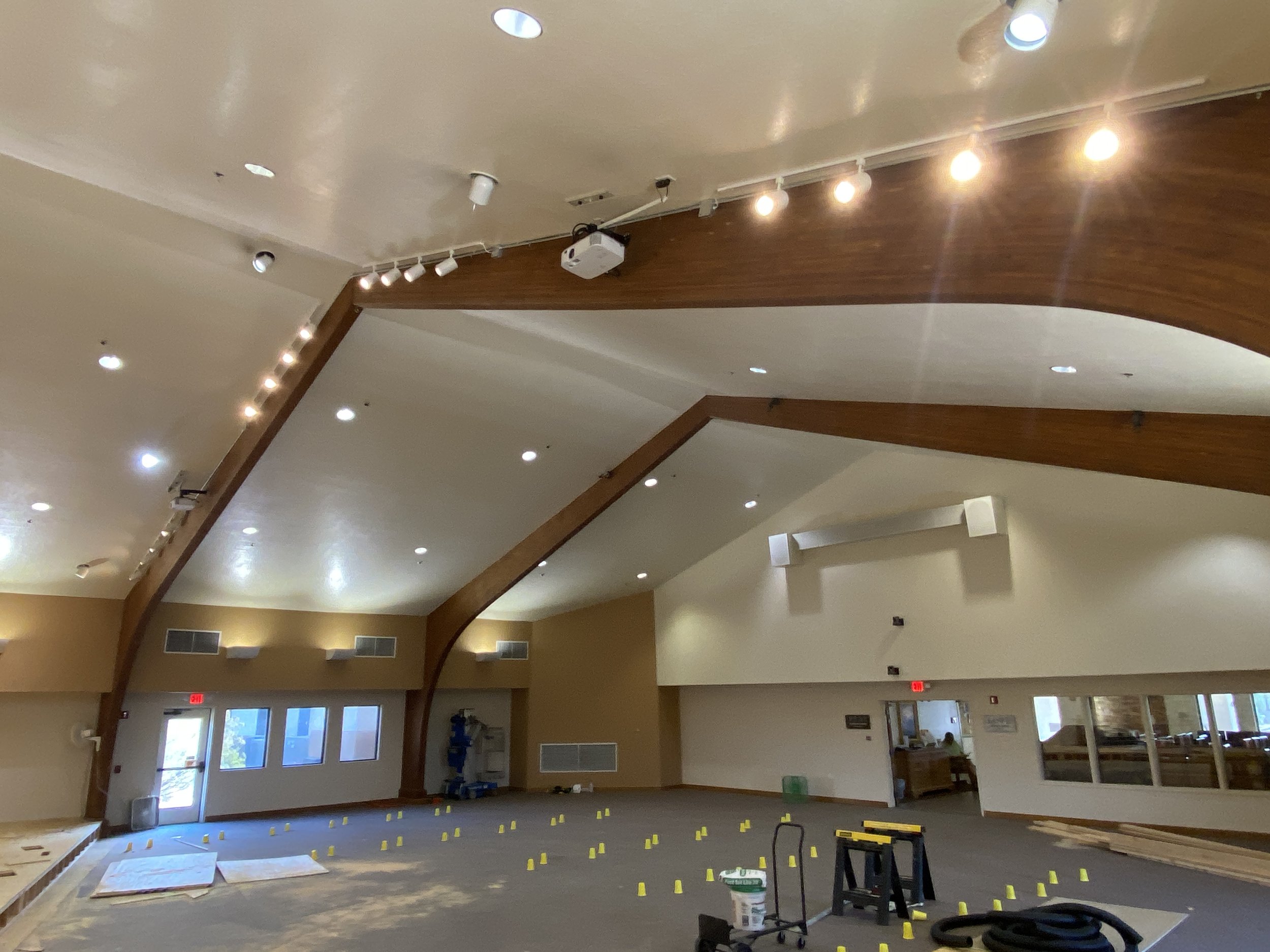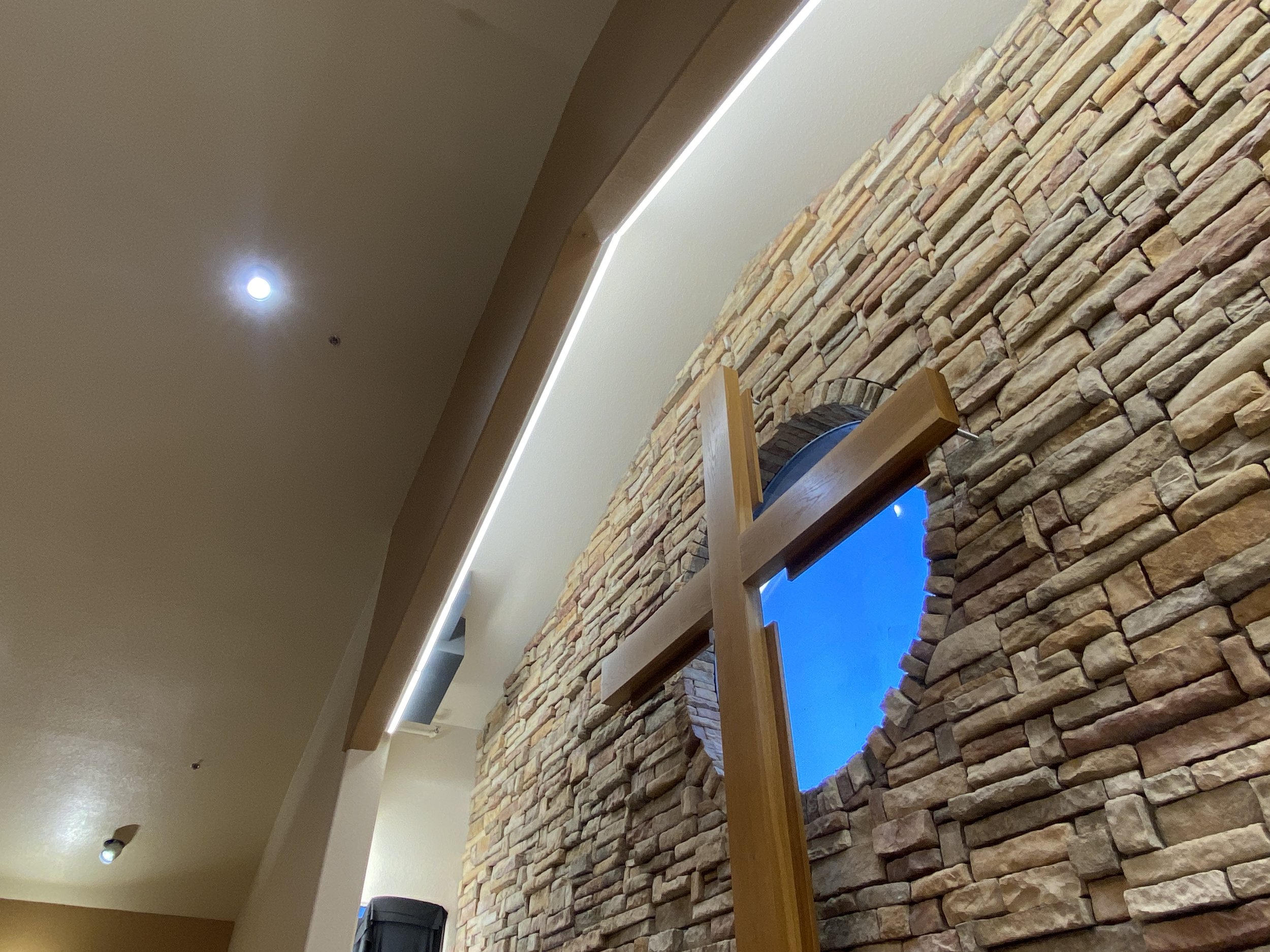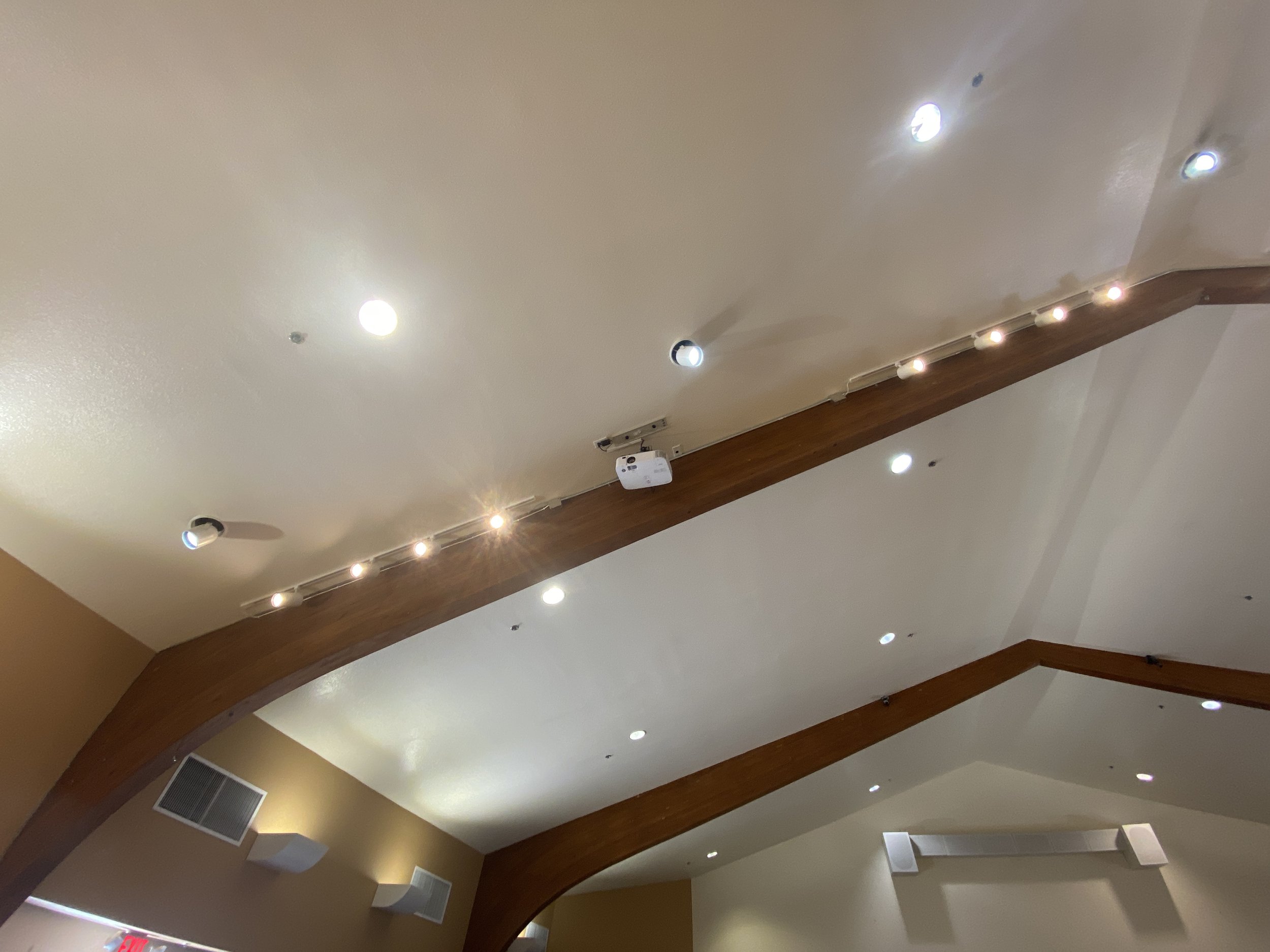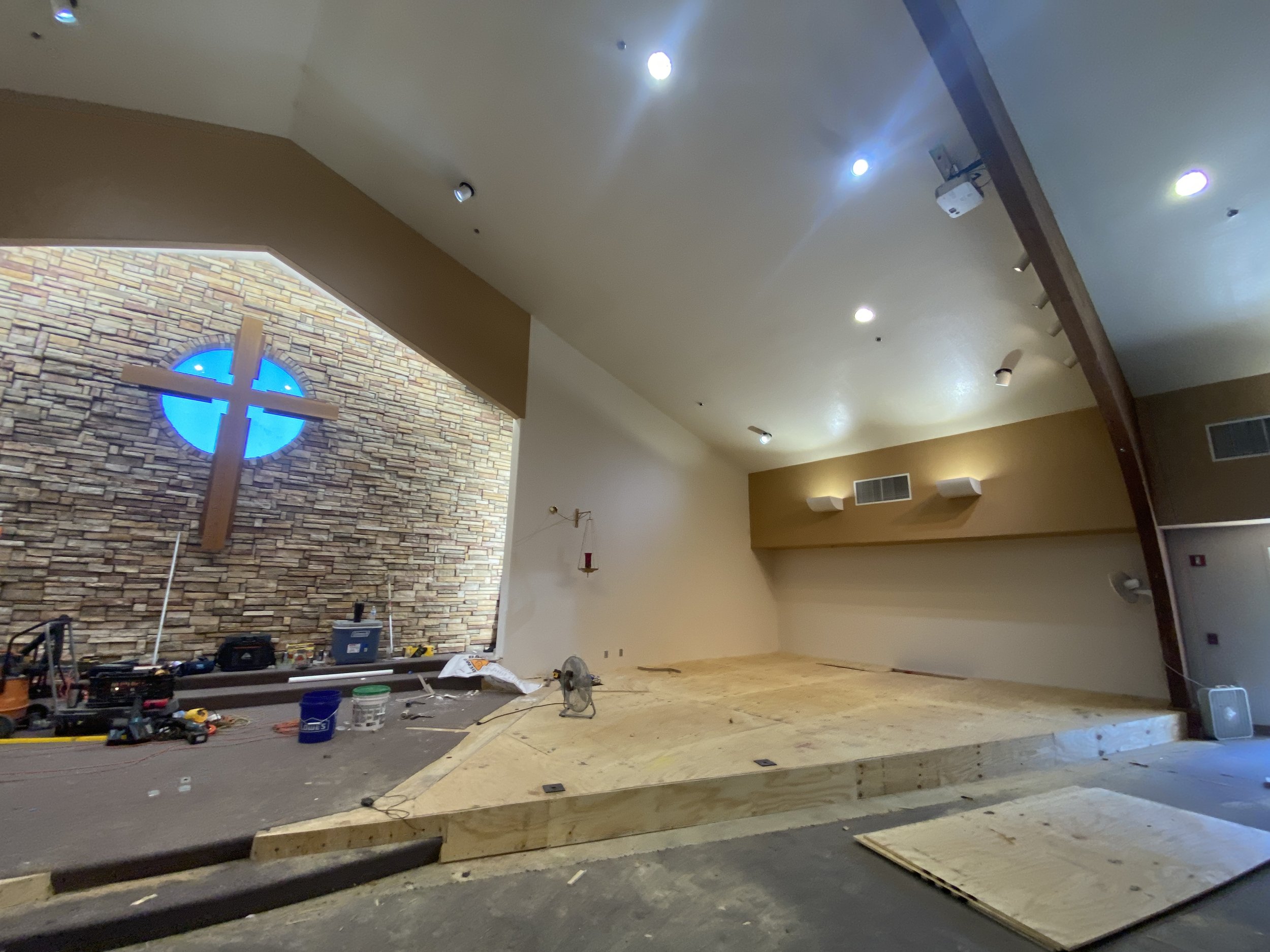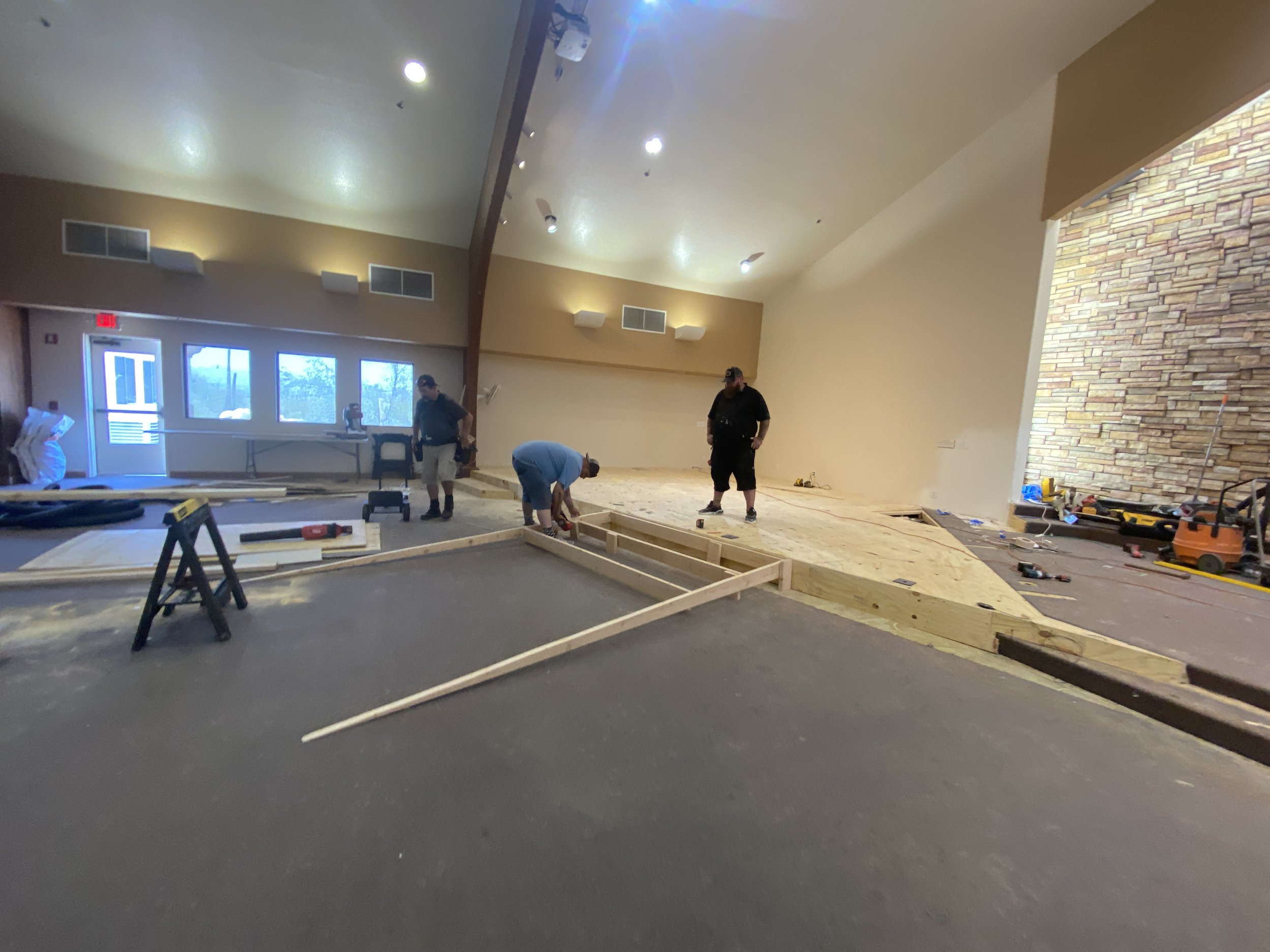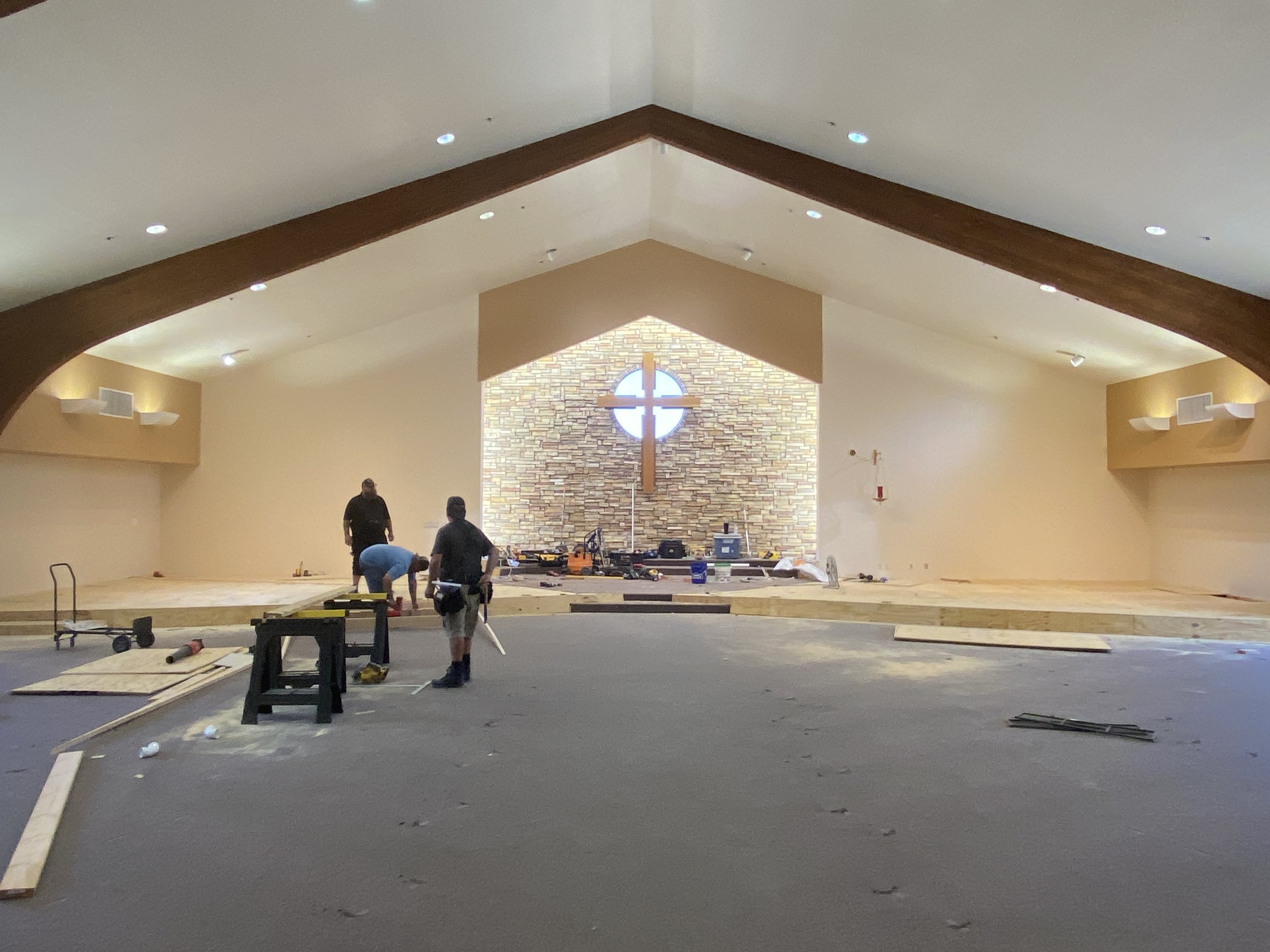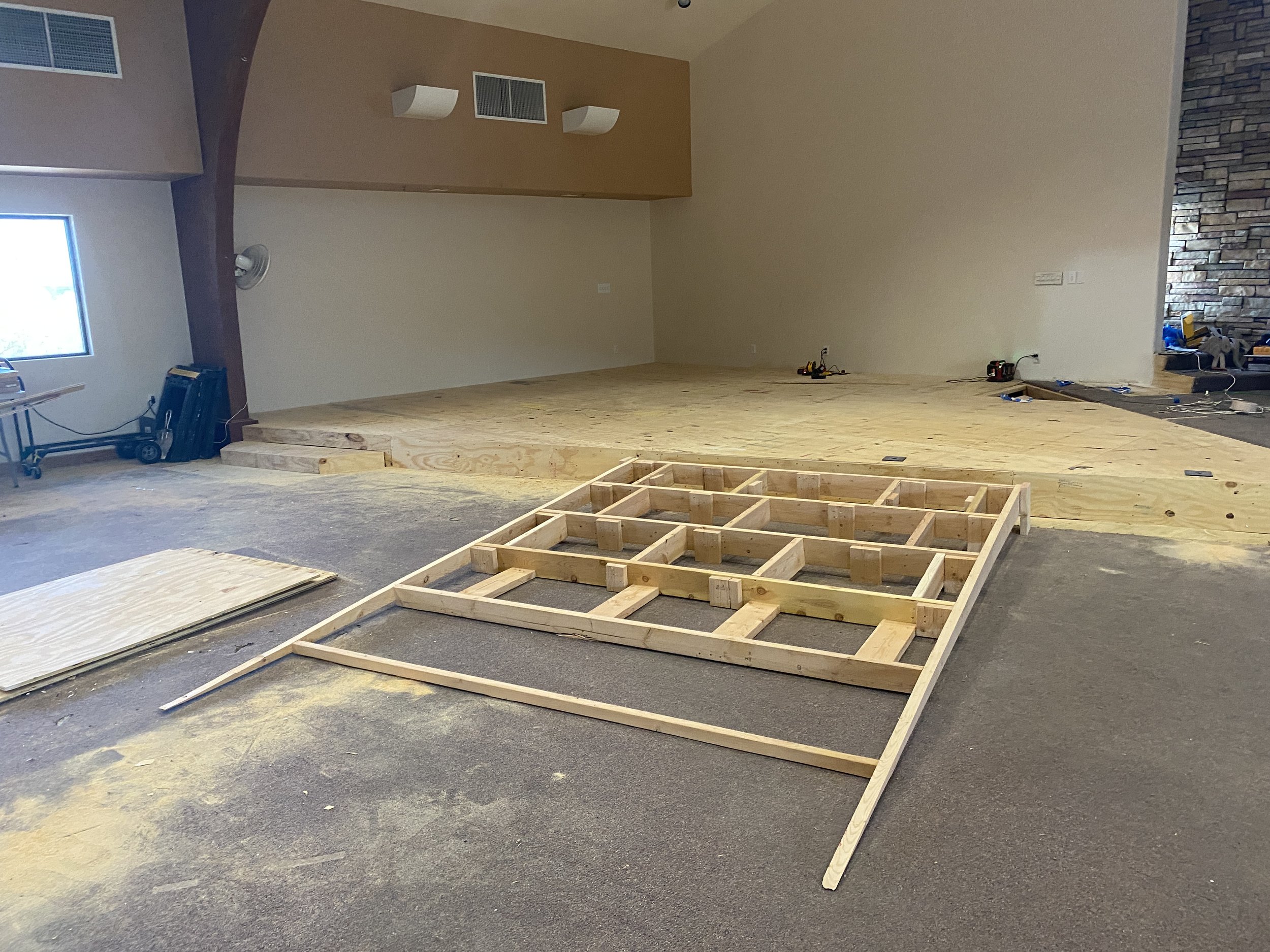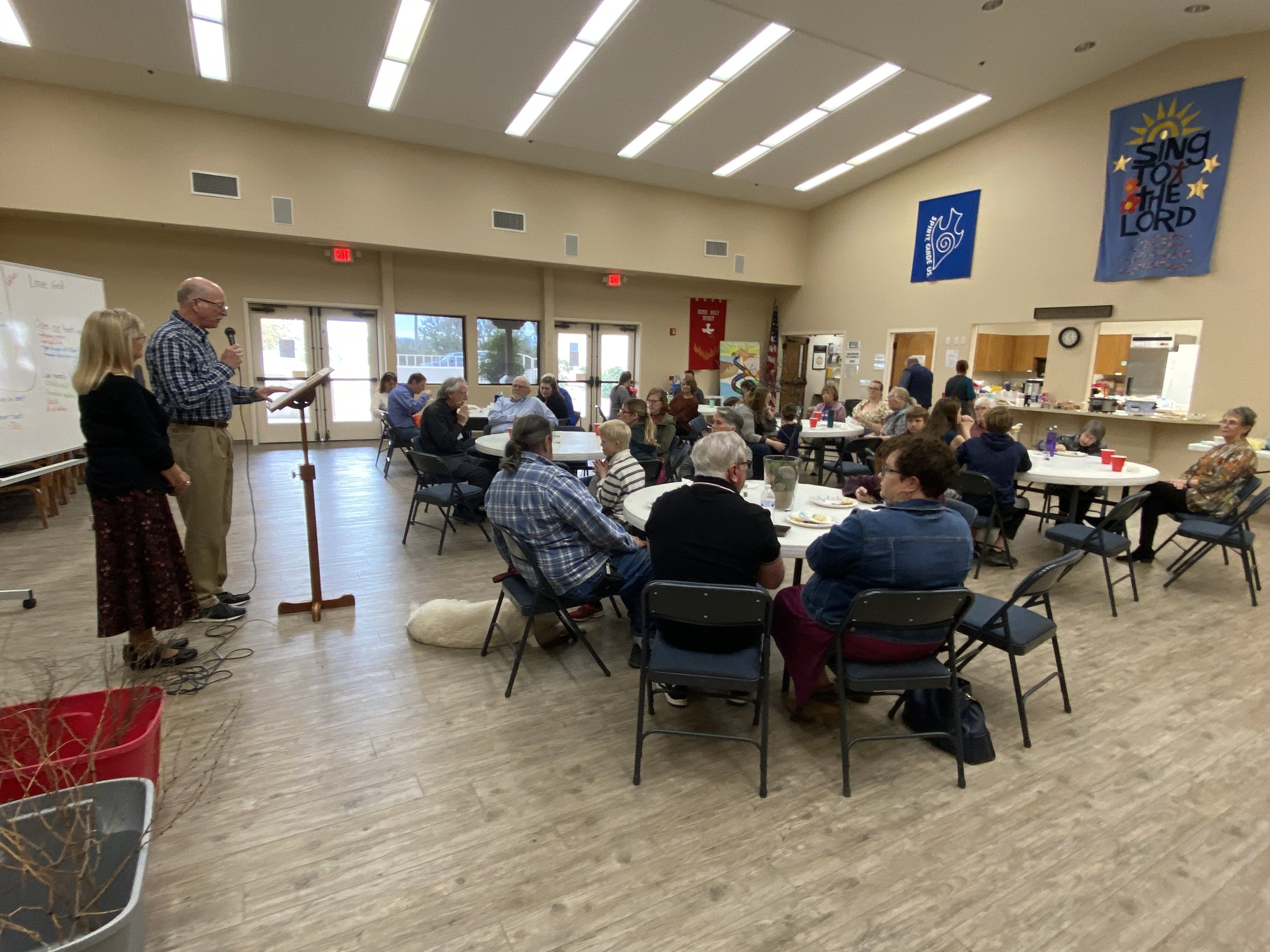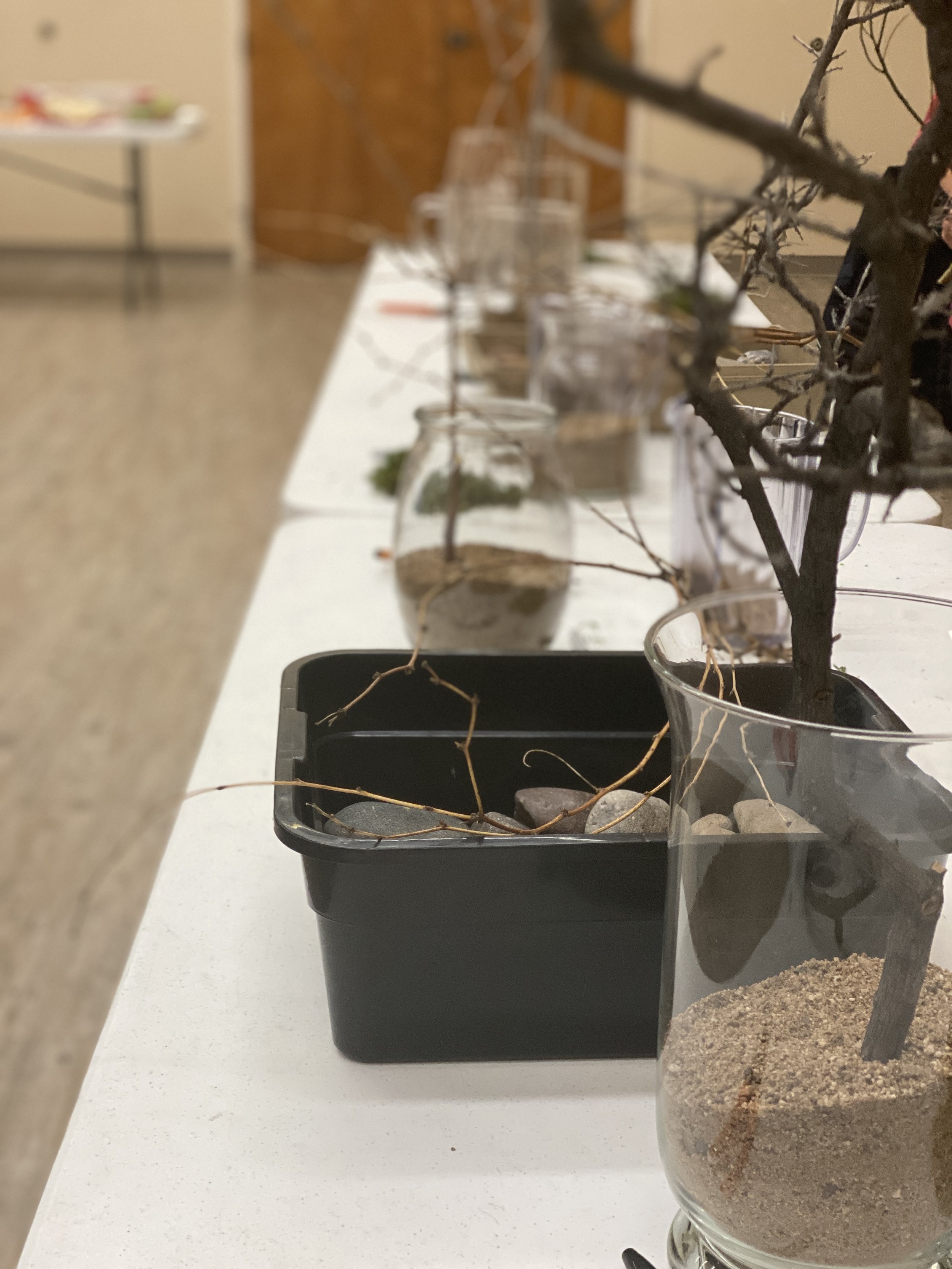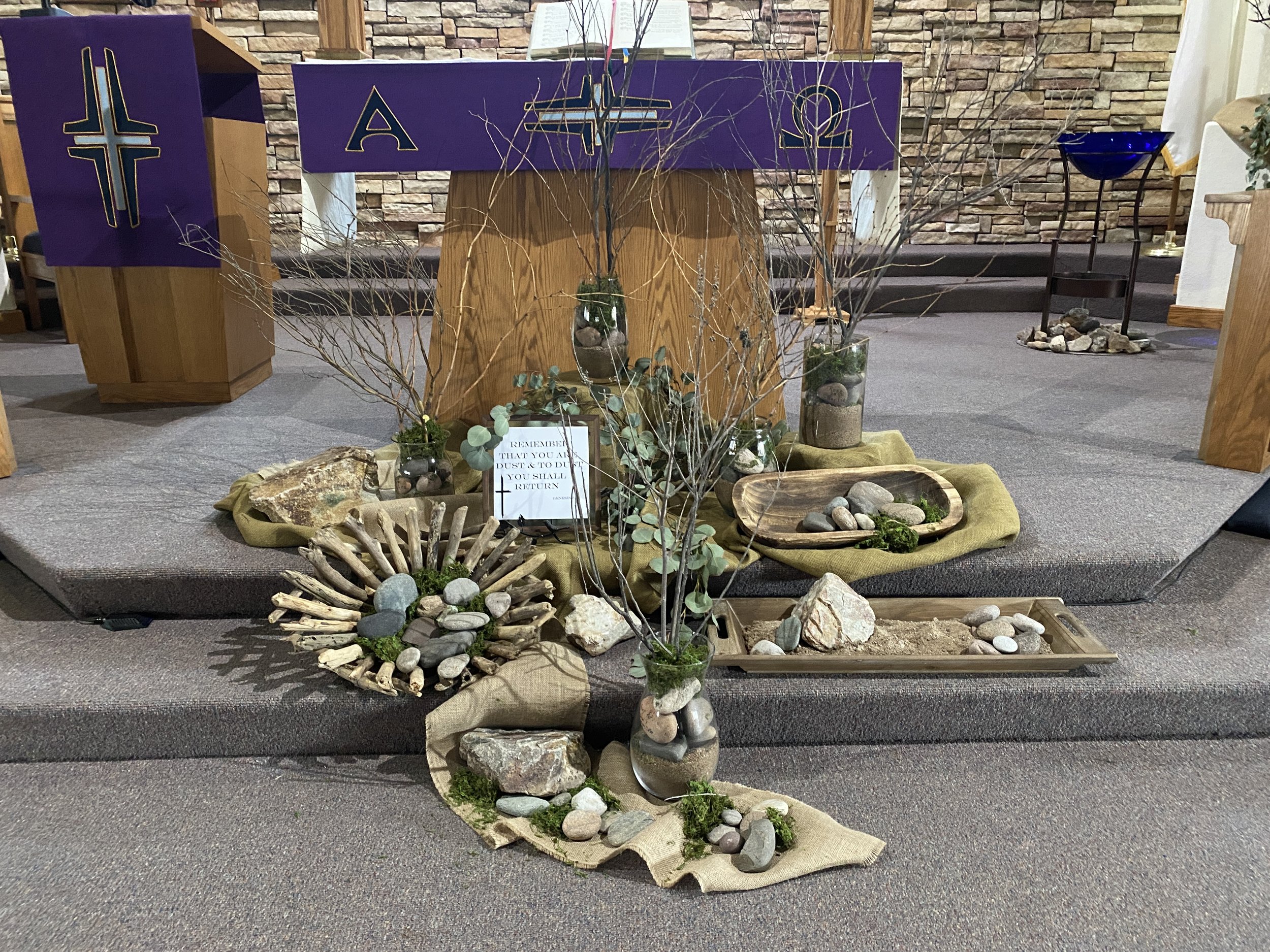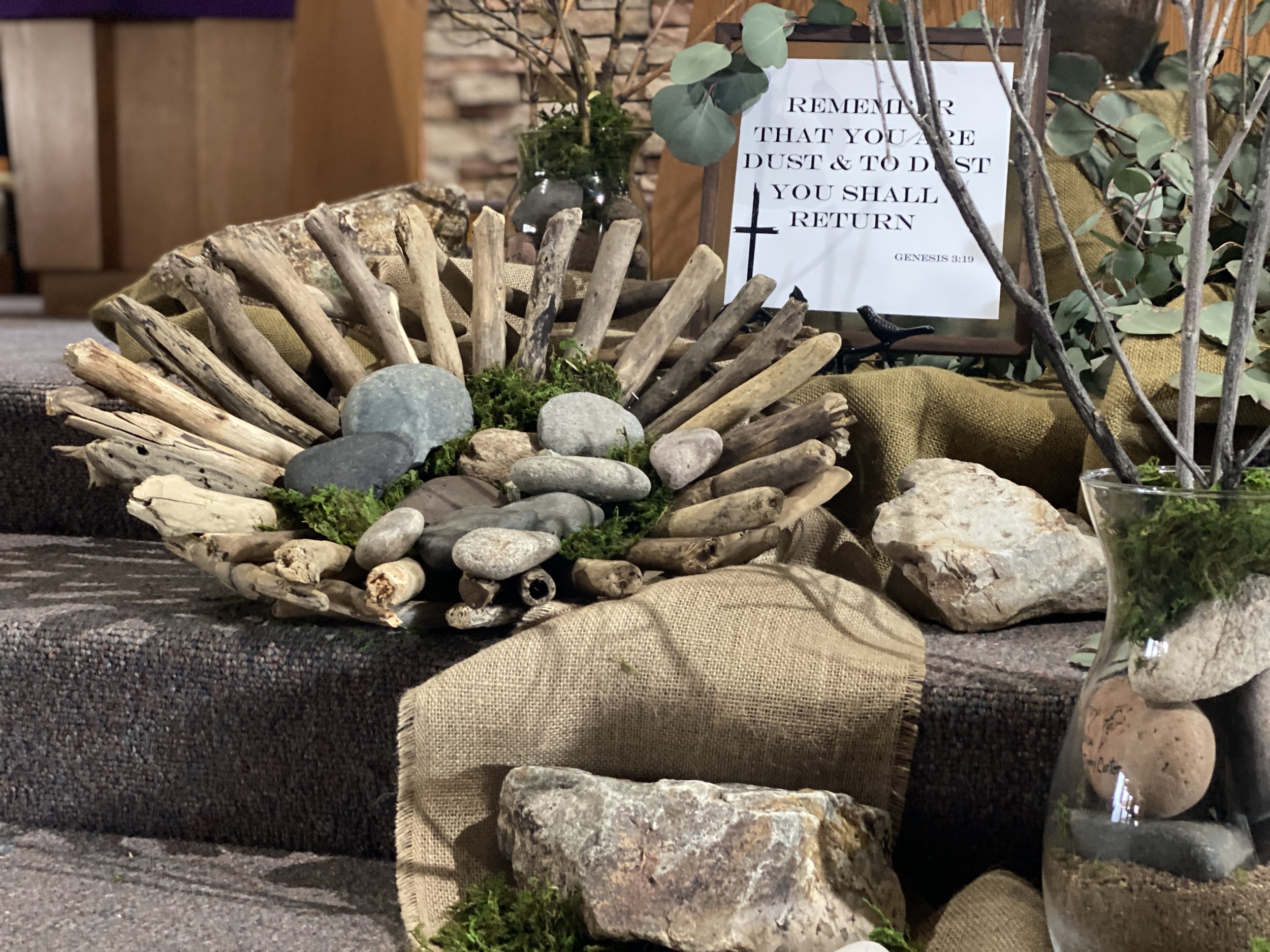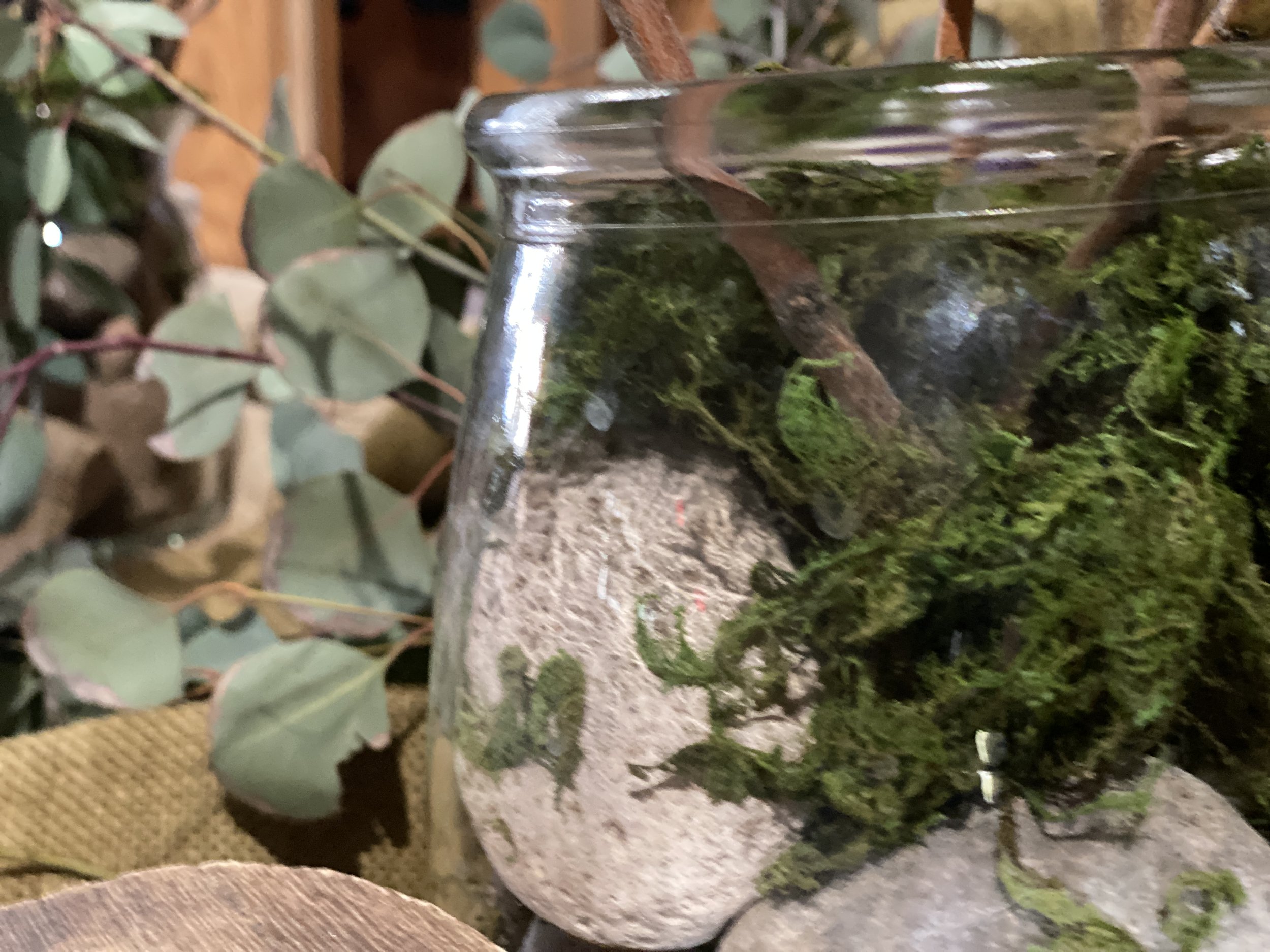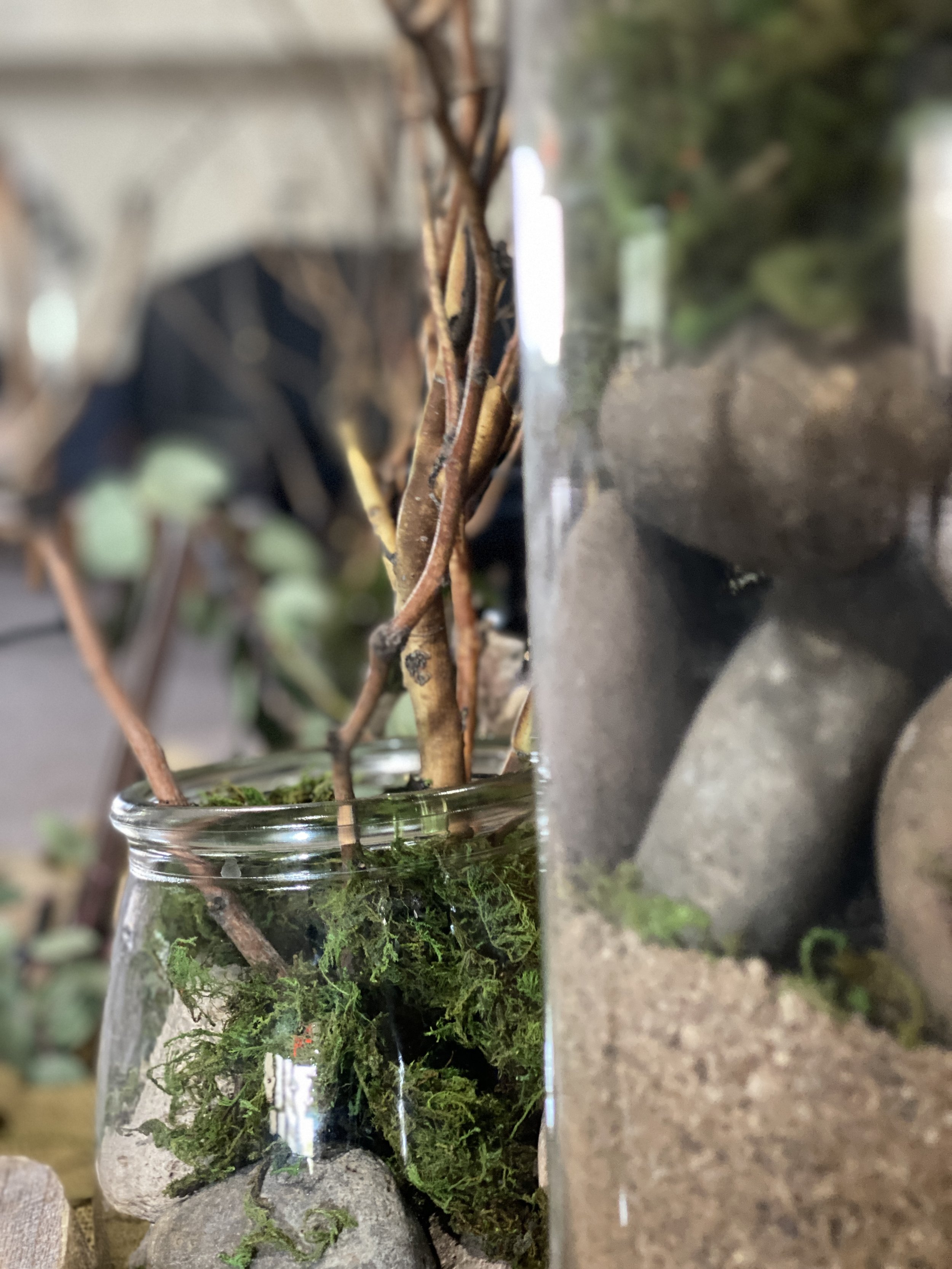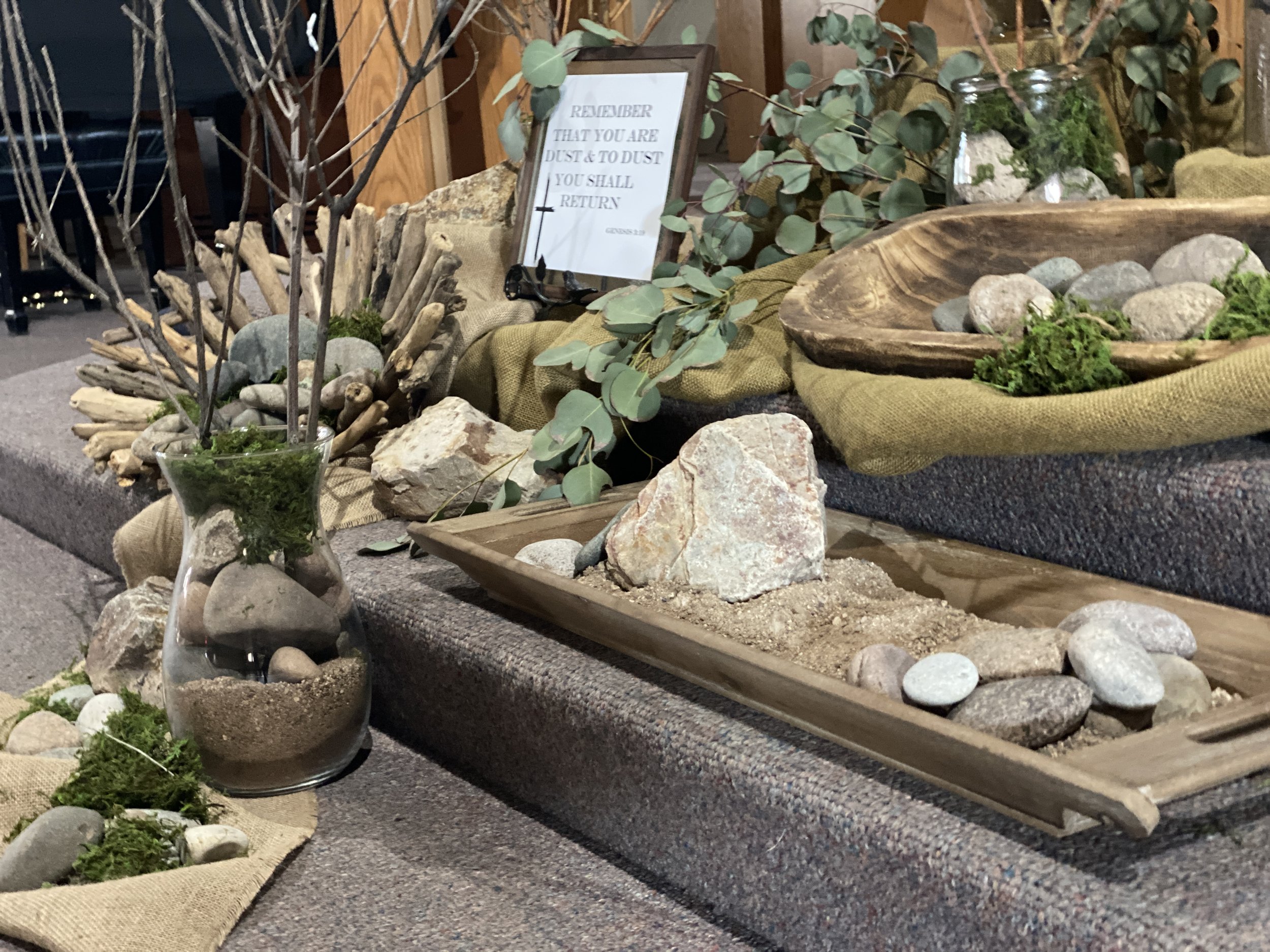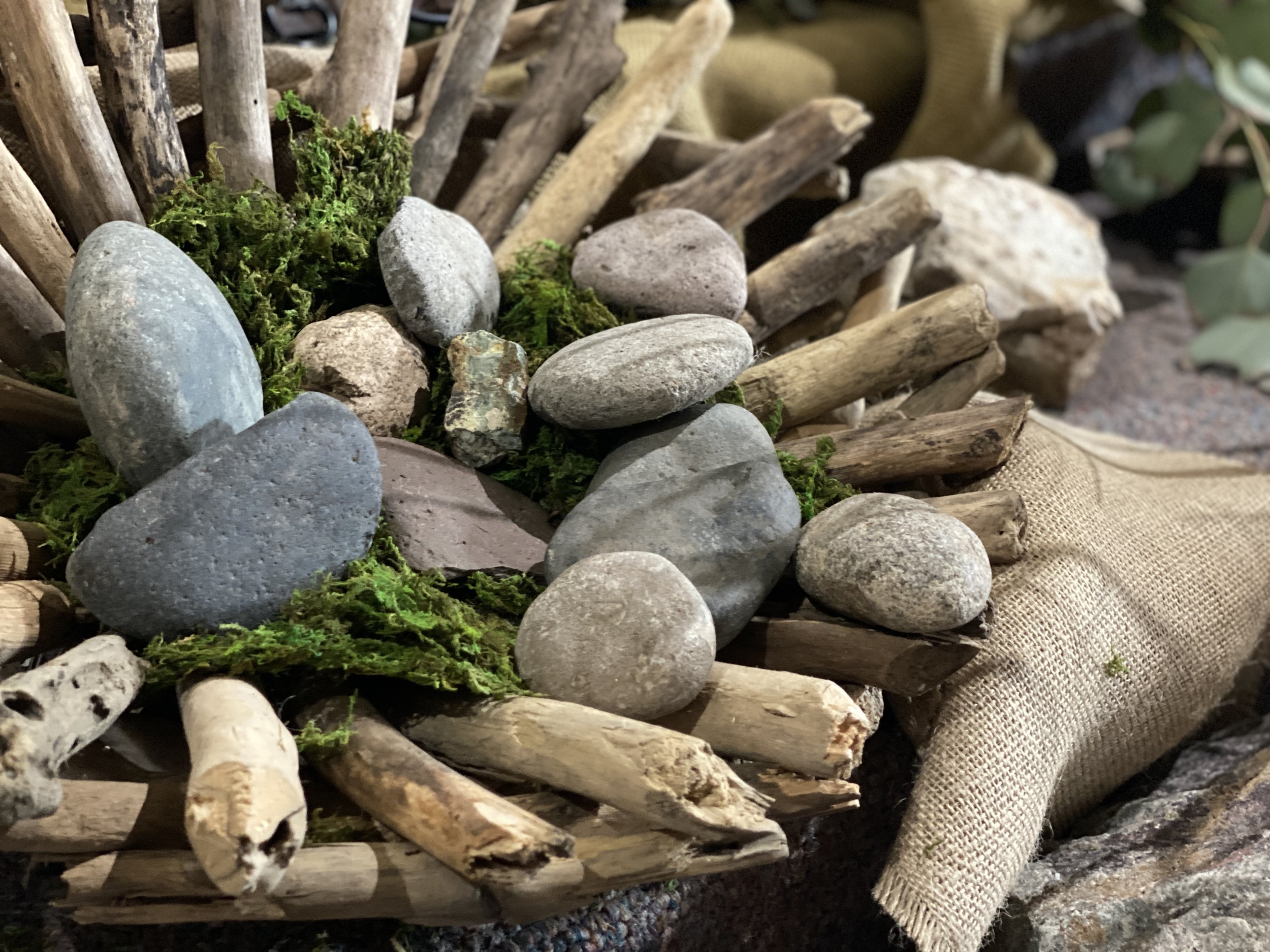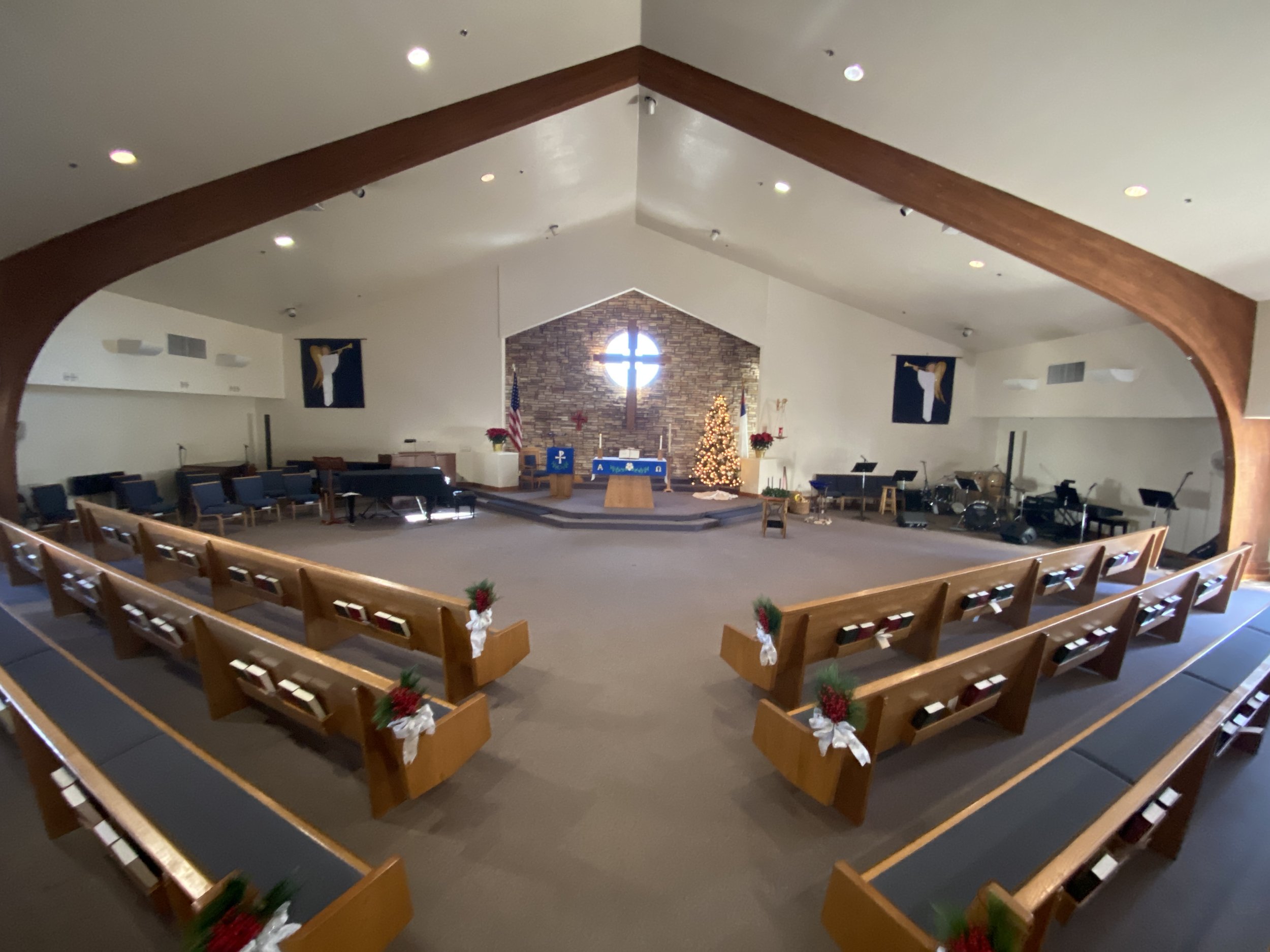New Hexagons for Sanctuary Liturgical Arts
With the remodel of the sanctuary, one of our plans was to have a cable-pulley system that can be used to hang liturgical art projects from. I copied the idea from one at Our Saviour's, where I would be in charge of lowering and raising the advent wreath each week. So I asked my dad to make two big hexagons that attach to a carabiner. He came up with the idea of using old pew wood, and made two of these. Right now one is hanging with Epiphany stars that the preschoolers made. They can be for Pentecost doves, Christmas garland, anything we want to make and hang and not have to get up on a lift.
So big thanks to Rev. Paul Hammar for constructing the hexagons. Big Thanks to Laura Tanem-Hernandez and the kids for making the stars, and the help from the Preschool Advisory Board in hanging them up.
Pastor Lars
Our Strategic Plan One Year In - Pastor's Column
It’s been about a year since we finished up the structure of our strategic plan, and we’ve been filling it in more and more as we go. The intention was always that it would be a living document, and that we’d update it as needed, and revisit it often. Our goals, just to review, were to create a new mission statement for Lord of Grace, then have ministry groups meet and pray and brainstorm ways they could implement that mission. So our team met and we came up with this statement:
Love God
Open Our Hearts and Minds
Live Graciously Towards All
So far we’ve been moving along with these. Let me share a few of the accomplishments.
Property brought back the semi-annual clean-up days. I’ve always enjoyed the fellowship as much as the brush cutting. Out next one is March 16th, and we’re doing the pews and chairs inside as well as the grass and brush outside.
Worship started work on the narthex. The last time we did much was back in 2012 when we got a special donation and bought the couches and leather arm chairs. In 2013 the carpet was added to the middle, and since then it’s been a somewhat unintentional collection spot. This time a team met and looked at things like function, values, goals. The team wanted to make the room useful, not just as a hallway, but as a welcome center for visitors on Sundays and a fellowship space after service. Yes, we have the big fellowship hall, but experience shows that after the 10:30am service, we don’t make that left turn.
So the first step was to remove all the things we weren’t going to use. This included the couches, the memorial book stand, the fake ficas, the book shelves that were in my office, then the conference room, then the hallway, then the narthex, and now they’re back where they started. As you can see, the room is pretty empty right now, because the new furniture hasn’t been purchased yet. The plan is to add some new chairs for seating, some side tables for coffee, a new coffee bar, a designated sign-up table, a shelf for books on prayer and health resources, and some things for children’s ministry. These will be purchased as we go, because the funds from the capital campaign are used up. If you’re interested in contributing to a part of the new narthex, just let me know. Here’s the things on our wish list:
L-shaped sign-in table. Kind of like a “welcome desk” you’d see in places, but big enough for clip boards.
Coffee Bar. Small cabinets on wheels for coffee supplies and refreshments. Primarily for after the second service.
Air Pods. Coffee shop grade brewers that will go in the kitchen, used for both services, and have removeable caraffes to go in the narthex after the second service - or any other event.
Area Rug. The current one is from 2013. We’d like to get one of equal or bigger size, with color.
Acoustical panels for the walls. Custom-made in shapes to mimic the rock wall in the sanctuary. Fabric on batting on a wood frame.
The panels are to deal with the sound problem. The original building committee put in $7/foot (in 2002 money) tile in the narthex for durability, I learned from an original member of the church building committee. . This means we don’t have to replace carpet from coffee spills, but the room echoes so you could do Gregorian chant with ease. The couches and center rug mitigated, but with the high ceiling and the rest of the tile, only somewhat. So the team has a plan to put up homemade sound panels on the walls for both color and echo reduction. Eventually, we’d like to get a new center rug with color as well.
Outreach has been super busy going over all the different projects we did as a church and seeing if we wanted to try some new things and retire some old. Just look in the narthex to see the multiplicity of things they’re spearheading.
A big one I’d like to highlight is the partnership with Roadrunner Elementary. The school is often forgotten, being on the west end of the district. It has a good portion of kids with low income, and we’ve stepped up with drives at Christmas and volunteering with their resource center.
Youth and Family has also jump-started some things. As I’ve written about many times, it’s hard for a church our size to field traditional “youth groups”. They require a critical mass of kids the same age, who also get along well, and a lot of staff/volunteer time. On top of that, they are not proven to be the most effective at keeping kids involved in the faith after graduation, in spite of the popularity they have with parents who are church-shopping. Parental faith witness, adults who know kids and care when they show up, the church being there for them in crisis, and getting involved in leadership all make way more difference than age-segregated youth groups.
That said, our focus has shifted back the old “Family Fellowship Sundays”, now called Community Days, we used to do them monthly after the second service, until Covid came. Now they’re back with a bit more organization, including often a theme and specific activities for after eating. It’s taking the little family church potluck and putting some steroids on it. Given that intergenerational witness is the most effective, I love the concept, and they’ve been well attended. We’ll keep these going at least through the school year, and review for fall 2024.
I met with the preschool teachers and our director, America Trujillo, to set goals for their ministry. It’s been a back and forth over the years how we define what it means to be a “church” preschool, as opposed to just a secular one that uses the building. Since there is no one prototype, I decided to have the teachers work on answering this question themselves, and, of course, they came up with far better ideas than I could have. Look for some new art and decorations, some things added to worship, some special drives for the community, and ways for us, as a congregation, to help out.
Of course, all these things are just a sampling, and they happen in addition to the regular work of ministry here at Lord of Grace.
Reflecting on the whole process, I always come back to the slogan about working smarter, not harder. There was a time, mostly in the 80’s and 90’s, when you could grow a church by adding buildings and adding programs. In fact, the more the merrier. People would see either how busy you were, and assume that as an indicator of quality, or would see a program for people “like them” – whatever that means – and find a connection to join. Really big churches still operate this way, because they have finances for large staffs to run things on an ongoing basis. For the rest of us, which is probably 99% of US churches, we run on volunteers and tight budgets. And, as the years go by, we are all finding that the supply of “labor” is not getting any bigger. Fewer people go to church, and those who do are often either busy with kids and family, or wish to retire from regular committee work. So we have to do more with less. It can be disheartening, if you’re trying to keep up with the big place down the road that always seems to have the giant youth group that does whitewater rafting and Christian rock concerts every month. But it’s the relationships, the connections, the spiritual practices, the community being community for each other and the world that has the biggest impact. That we can do by:
Doing what we do better, nor necessarily more.
Making a point to get to know who we’re worshiping with, learning each others’ names and asking each other, honestly, about how life is going
Pray together and support one another in time of need
Invite people to worship and invite people to join us in our service projects
Get involved in, and support one another, in spiritual practices that help people experience Christ.
Christianity is growing through conversion in large parts of the world, in countries with little money and in churches that are small and meet underground. Programs are not why Chinese churches are getting bigger. We can step back, take a deep breath, and see the gifts we have and the impact we can make by working smarter, and more spirit-led, with what God has given us, and get off the treadmill of trying to compete with laser shows and adventure camps.
The new stations of the cross images
12 posters of stations will be set up around the sanctuary from 11am-1pm and you can soak them in at your own pace. At night the images will be on the screen with the worship liturgy.
On that note, this month is Lent, and Holy Week, and Easter. We get it all. Lots and lots of opportunities to worship, pray, reflect, and come closer to God. Worship is something we do well, and a great way to encounter God and one another. So whatever you volunteer in, I’ll personally invite you to join us at the Lent services on Wednesdays, where we contemplate, reflect, and discuss Bible stories about the disciple Peter. We even get original music by Stuart Oliver, composed just for our services. They’re casual and interactive, and you get wine and cheese after (we’re going full Episcopalian for Lent).
Then comes the agape meal for Maundy Thursday, and a new format for Stations of the Cross. We’re adding an 11am-1pm walk through the stations on your own in the sanctuary. The stations are on posterboard, and you’ll have a chance to go around and write and look and pray over each one at your own pace. At night will be a full worship service, with music and sermon and the pounding of nails.
So many ways to step back, breathe deep, and let the Holy Spirit soak in. What happens next happens next, and God will show the way.
Peace,
Pastor Lars
How Does a Weary World Rejoice - Advent 2023
A couple years ago I decided that I was going to make Advent into something special, a bit of a big deal. My phrase was to “make Advent a thing”. The initial inspiration came in fall 2021, in the middle of Covid, as we were preparing ourselves for something, but really tired out from everything. It was hard to be giddy and all wassailing with so much stress. We needed a space to step back, reflect, heal. Then, as we were getting more of our services online, the idea came to bring back mid-week Advent services as a time for that healing and processing. If people couldn’t physically come, we could put it online. Maybe someone far away would find God’s presence in the time.
Since then I’ve tried to lean into Advent, making it its own big deal, but finding ways to do that that are relevant. Years ago I gave up preaching the appointed texts in the lectionary (the set of Bible readings that come with each day of the church year). They usually include John the Baptist calling the priests a “brood of vipers”, Jesus prophecying the end of the world; John the Baptist getting his head cut off; and maybe a little Virgin Mary the last week. It was so tone deaf, in a hectic season saturated with emotions, memories, events, we were preaching about “bearing fruits worthy of repentance” so we wouldn’t get burned in the fire. I couldn’t do it anymore.
Advent is not just a time of getting ready for Christmas, not in the church year. Originally it stated mid-November, and could run as much as seven weeks. It coincided nicely with themes of darkness and long night for our northern European friends. They wrote some of the best hymns in the book for it. And, for them, it probably had little to do with John the Baptist either. It was spending lots of time huddled together telling stories, reading the Bible, and eating the dried food you processed in the fall.
This year I’m going with a theme that I got from a Christian art collective called sanctifiedart.org. I’ve used their stuff before, because it’s creative, comes with pictures and poems and lots of really good reflections on life and faith for the season. This year the theme is “How Does a Weary World Rejoice?” It’s not about weariness, as much as honestly finding the space in ourselves to rejoice in the face of it. Too much modern Christianity, in my opinion, glides over topics of grief, loss, struggle, doubt in favor of a manufactured rejoicing that can feel disjointed to the pains of modern life. Yes, I want to celebrate the season, but….my husband/wife/child died around this time and all I have are memories of loss that keep coming up. Yes, I want to smile and laugh and share a warm cider, but…..I’m drowning in anxiety about the state of the world. Of course I want to win the holiday school bake-off, but…..I am worried about my kids’ future. We’re not trying to wallow in grief, but grief finds us, and won’t let us push it aside. We want to sit in God’s presence, feel the warmth of the glow of grace, in the place where we are now.
That’s why I was so excited about this theme. We’re going to rejoice, but do so authentically. We’ll take a look at four different stories in the Gospel of Luke that lead up to Jesus’ birth, and reflect a bit on the people, their stories, their struggles, their joys, and their encounters with God. We’ll walk through with them, and let them guide us to light in the darkness, and hope in the midst of pain.
Each Sunday will be a different story. I’ll give handouts to everyone with the images, poetry, and reflections for the day when you come to the service. December 6th will be a healing service, a space for you to dwell and reflect on the wounds/pains/traumas/stresses you have and bring them to God in prayer. Our prayer team will be there to pray with you. It will be livestreamed, and we will monitor and respond to online prayer requests as well.
On December 17th will be the Longest Night service, specifically tailored to finding space to process grief, loss, and related concerns right before the big Christmas celebrations. The service will follow an order based around the theme of “rejoicing in a weary world”, and will include dedicated chunks of time to sit back, pray, reflect, and bring your grief to the God who loves you and is with you in all things. Also livestreamed.
December 24th falls on a Sunday this year, and we will do a combined service at 10am in the morning, using the traditional/liturgical format – with the children’s sermon, kids chat, and the Advent themes.
Christmas Eve services will be 6pm contemporary and 8pm traditional services.
As usual, no services on December 25th.
The next service is the combined service of lessons and carols on December 31st at 10am.
More Sanctuary Progress
The sanctuary renovations are coming along. Sam Lyth, the project manager for the sanctuary renovation, has been hard at work with our contractors upgrading the space. Thanks again for all your support to the capital campaign which makes this possible.
Here’s some pics of the progress the last few weeks.
Platform getting exteded and framed,
wall sconces repaired
track lighting added to the ceiling behind the front beam
lighting installed around the stone wall
pews removed and sent to the carpenter for shortening.
As of writing (June 28), the platform is finished with construction, with tubes for microphone cables and hatches in the floor cut. A ramp is being built to move the piano and organ back.
Coming up:
More light adjustments and replacement to higher power bulbs.
Adjusting lights and positions
Increase the size of the image projected on the walls
carpeting in the whole room
pews returned and moved back in, with chairs in the place
Mural painted on the back wall, above the doors
Condenser microphone added to the back of the room to improve audio for livestreaming
Vase-Making for Lent
This lent we’re following a theme of “wilderness” throughout our mid-week services, and our sermons. In preparation, we put together all these vases (based on an idea from sanctifiedart.org) to place in front of the sanctuary for the Lenten season.
To build them we had a lunch after the second service, and then had a little liturgy where we would read a poem, based on the idea for each part of the vases, complete that part, and read again and so on.
All ages were there, kids through seniors, and we made some really cool additions to our sanctuary. A big thanks to the liturgical arts team for all the work of hunting down all the supplies, especially finding all those big vases at thrift stores.
The Church Emerging - Pastor's column Jan 2023
As I was starting in ministry at the end of the 1990’s a movement was starting called “emerging church” (I won’t capitalize it, because, to be cool, they never capitalized anything either). It was full of Gen-X pastors with grunge music in our CD players and postmodernism in our philosophy books. Buzzwords like “deconstruction”, “juxtaposition”, and “bricolage” were all the rage. We wanted something in our churches that seemed to resonate with a new way of thinking and experiencing God, something of a more fundamental change than just updating the musical style and having the pastor rip his jeans and untuck his shirt (an evangelical liturgical garb that has shown amazing staying power). The idea was that, in a post-modern world, people didn’t learn or experience in a strictly linear or verbal way, which is how most church worship has been for centuries. What about non-linear worship, with multiple things at once? What about art and visual media? What about being hands-on, interactive, making things with clay or putting things up? And, does the sermon have to be like a one-way lecture, or could it be interactive?
Emerging worship service I did at Our Saviour’s in Tucson back in 2006. We had tables to sit on, candles on the altar, and this paint project called “the tree of life”, where I projected the tree onto the hanging muslin with an old-school overhead projector. We then painted the tree during the service, and turned the projector off to see what the new tree looked like.
All of these concepts were backed up, to some degree, by research into cognition and pedagogy. We know that we remember better when we reinforce the idea with physical interaction, and we know that lots of people learn better with visuals than just hearing. But to bring that into worship? What would that look like?
So some early pioneers did the metaphorical, and sometimes literal, raiding of the attic. They pulled out the old velvet couches and brass candlestands and icons that had been put away by the church-growth experts as being too “churchy” and not “seeker sensitive” enough. And they got the old sanctuary or the small chapel, decorated it with paintings, and had people sitting scattered around with prayer stations, ambient music, and art projects. It was like Montessori church with candles.
An emerging worship service I did in 2014 called “encounter”
To a lot of people, this was ridiculous. To those of us on the inside, it was the coolest thing ever. I remember how impactful it was to experience the first time, and how excited we were to do this new thing. Of course, no sooner did the evangelical churches hear about “emerging” as the new thing, but they tried to hand the “youth pastor” a budget and the old “youth room” to do that “gen-x outreach”. But, underneath it all, they kept the same fundamentalist theology and social politics. Bible=literal. Women=submission. Marriage=one man one woman and nothing else. It was, for them, a new stylistic fad to bring in new recruits, not a sea-change in worldview.
Emerging Theory is a scientific and philosophical concept that goes something like this: when an organism forms to a certain point, characteristics come about that are not simply predicted by the building blocks of the organism. In other words, things like life, consciousness, feeling, reason, meaning start to be thought of, but simply combining the molecules in the body doesn’t predict this. It’s sort of like a leap is made where the new organism is greater, and a step above, simply the sum of its parts.
A prayer station with icons from the House For All Saints and Sinners in Denver. Note the bean bags to sit on, “juxtaposed” with the icons, candles, and christmas lights. It’s creating a sense of holiness and transcendence, along with warmth and comfort.
For church work, this became adapted to be something more like, if a bunch of Jesus followers come together to pray, explore, learn, support – that something bigger is spontaneously created (with the Holy Spirit) than just individuals in a room. But it isn’t really something you can craft, but something that emerges from the group. You create the conditions for exploration, experience, belonging, and the form of the church and the truth and the experience will emerge.
You can see how this, ultimately, didn’t work with churches that are either heavily doctrinal, as they worry about how to make sure what emerges conforms to the beliefs we already know are right. And it also tends to get squashed if it’s within an existing church that has power structures and traditions that get threatened by the “weird stuff those kids are doing in the old chapel”. Like all creative things, it had to have it’s own space, it’s own context of both freedom and faith to succeed. And, it’s hard to replicate on a mass scale. The old fashioned “charismatic pastor with good band and lots of youth programs” still worked better for that.
Now, twenty-some years later, “emerging church” isn’t much of a thing. The upstart communities struggled to maintain good order and deal with institutional realities (paying the pastor, the rent, doing stewardship – the bread and butter stuff that you can’t wait to “emerge”). But the concept of learning non-linearly, and embracing art and creativity, and making worship flexible and collaborative, and focusing on context as “setting a space for people to encounter God” are still good insights we learned from it all. I hope to keep them.
We’ve experimented with interactive prayer stations and hands-on worship at Lord of Grace, mostly in mid-week services. Here’s a prayer wall from 2021 made from chicken wire fence mounted on a wood frame. People put their prayers on paper, rolled them up, and stuck them in the holes. It’s reminiscent of the Wailing Wall in Jerusalem, the last foundation, and all that remains of Solomon’s temple in Jerusalem.
Which brings me back to Lord of Grace and our two big initiatives right now: the strategic plan and the capital campaign. The strategic planning committee has been meeting, and developing a new mission statement, and will be coming around to the different ministries to ask questions about how you can help the church accomplish its goals. How can your group connect with the non-religious in our community, and change lives, and spread the Gospel? The plan is that we will ask the questions, and pray that the ideas and actions that will move us forward will, with some guidance, “emerge” from among us. It’s exciting work, once you get into it, to let the spirit speak to you and get inspired about making a difference.
The second part is the capital campaign. To date we have completed:
· Exterior painting
· Painting the fellowship hall
· A mural
· New roof underlayment
· Livestreaming equipment
· Two new HVAC units (sanctuary and narthex-nursery)
· Tiling in the fellowship hall and classrooms.
It’s been amazing how much we’ve done. I have to thank everyone again for all your generosity that made it happen.
The next phase will be to look at our sanctuary. A team has been put together to make recommendations to the council for upgrading and turning our sanctuary into a worship space that will be most effective. Other than removing some pews, little is different since 2002. The carpet is original, and needs to be replaced, along with some basic maintenance things. But when the team met this month we had a good discussion about what kind of room would be best for the next 20-30 years. That required digging back into the old wisdom of emerging church, and talking about the values we want to convey, the way people experience God, what kinds of uses might be needed, and how to make the space flexible for new and creative worship experiences.
We will have forums coming up, once plans are more concretely formalized, to show everyone everything we’re looking to do. But to give you a sneak-peak at some of the values and ideas that came out initially.
Warmth
Art
Beauty
Creativity
Flexibility
Color
Nature
Freedom
Openness
Community
Multi-Generational
Christ-Based
Our sanctuary today (taken in Advent). We’re imagining what we could do with this, how make it a place for future generations to encounter God. What could bring us into the future? The room is one thing that I consistently get feedback from visitors on, particularly the rock wall with the cross. it conveys a sense of transcendence and warmth that people are drawn to.
The plan is to start with the inspiration, the values, and work down to the specifics, let the specifics emerge from the brainstorming, instead of jockeying and negotiating between personal preferences. We want to position our sanctuary to be a space to encounter God, not just today, but 30 years from now. You can’t predict what that will be, but you can create a “context” for the next generation to experiment and experience in.
Doing God’s work today is not a game of just working harder, but when you can’t predict so much of the future, and things change so quickly, you have to be in a perpetual state of openness to the Spirit and adaptability, to let God speak and let the new direction emerge from prayer, community, and worship.
Peace,
Pastor Lars
Advent Mid-Week Worship - Dec. 7, 2022
Mid-week Advent healing service from Lord of Grace Lutheran Church. Meditate, reflect, refresh, and take time to be in the presence of God and bring your concerns and thoughts to God in prayer.
Original music by Stuart Oliver of oldbisbeerecords.com
Liturgy by Sara Are of sanctifiedart.org
Special Musicians at 10:30am service Feb 13
Back from North Carolina, Arizona and the Four Corners banjo champion Rudy Cortese, and his partner Elizabeth Kronlage, joined us this Sunday for special music.
Lent Sermon Series - Questions for God 2.0
For Lent, the forty days before Easter, this year we will continue our series on “Questions for God”, exploring topics of faith, doubt, struggle, and loss. Why do we find God in darkness? Does God really help those who help themselves? Why aren’t we all promised victory?
Both services.
March 10, 17, 24, 31, April 7







